CD147 mediates intrahepatic leukocyte aggregation and determines the extent of liver injury
- PMID: 31291257
- PMCID: PMC6619953
- DOI: 10.1371/journal.pone.0215557
CD147 mediates intrahepatic leukocyte aggregation and determines the extent of liver injury
Abstract
Background: Chronic inflammation is the driver of liver injury and results in progressive fibrosis and eventual cirrhosis with consequences including both liver failure and liver cancer. We have previously described increased expression of the highly multifunctional glycoprotein CD147 in liver injury. This work describes a novel role of CD147 in liver inflammation and the importance of leukocyte aggregates in determining the extent of liver injury.
Methods: Non-diseased, progressive injury, and cirrhotic liver from humans and mice were examined using a mAb targeting CD147. Inflammatory cell subsets were assessed by multiparameter flow cytometry.
Results: In liver injury, we observe abundant, intrahepatic leukocyte clusters defined as ≥5 adjacent CD45+ cells which we have termed "leukocyte aggregates". We have shown that these leukocyte aggregates have a significant effect in determining the extent of liver injury. If CD147 is blocked in vivo, these leukocyte aggregates diminish in size and number, together with a marked significant reduction in liver injury including fibrosis. This is accompanied by no change in overall intrahepatic leukocyte numbers. Further, blocking of aggregation formation occurs prior to an appreciable increase in inflammatory markers or fibrosis. Additionally, there were no observed, "off-target" or unpredicted effects in targeting CD147.
Conclusion: CD147 mediates leukocyte aggregation which is associated with the development of liver injury. This is not a secondary effect, but a cause of injury as aggregate formation proceeds other markers of injury. Leukocyte aggregation has been previously described in inflammation dating back over many decades. Here we demonstrate that leukocyte aggregates determine the extent of liver injury.
Conflict of interest statement
The authors have declared that no competing interests exist.
Figures
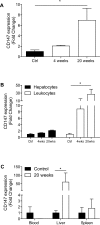
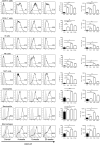

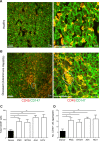
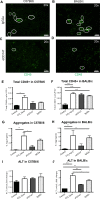
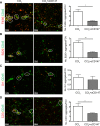
Similar articles
-
Hepatocyte produced matrix metalloproteinases are regulated by CD147 in liver fibrogenesis.PLoS One. 2014 Jul 30;9(7):e90571. doi: 10.1371/journal.pone.0090571. eCollection 2014. PLoS One. 2014. PMID: 25076423 Free PMC article.
-
Expression of Matrix Metalloproteinase-2, Tissue Inhibitor of Matrix Metalloproteinase-2 and CD147 in the Traditional Chinese Medicine "Compound T11" for Treatment of Chronic Liver Injury.Pharmacology. 2019;103(3-4):128-135. doi: 10.1159/000495141. Epub 2018 Dec 13. Pharmacology. 2019. PMID: 30544104
-
CD147 Promotes CXCL1 Expression and Modulates Liver Fibrogenesis.Int J Mol Sci. 2018 Apr 10;19(4):1145. doi: 10.3390/ijms19041145. Int J Mol Sci. 2018. PMID: 29642635 Free PMC article.
-
Repressing CD147 is a novel therapeutic strategy for malignant melanoma.Oncotarget. 2017 Apr 11;8(15):25806-25813. doi: 10.18632/oncotarget.15709. Oncotarget. 2017. PMID: 28445958 Free PMC article. Review.
-
Hepatocytes in liver injury: Victim, bystander, or accomplice in progressive fibrosis?J Gastroenterol Hepatol. 2015 Dec;30(12):1696-704. doi: 10.1111/jgh.13065. J Gastroenterol Hepatol. 2015. PMID: 26239824 Review.
Cited by
-
Multi-omic analysis characterizes molecular susceptibility of receptors to SARS-CoV-2 spike protein.Comput Struct Biotechnol J. 2023 Nov 10;21:5583-5600. doi: 10.1016/j.csbj.2023.11.012. eCollection 2023. Comput Struct Biotechnol J. 2023. PMID: 38034398 Free PMC article.
-
ACPA-CD147 axis in the NLRP3 inflammasome of RA macrophages.Cell Mol Immunol. 2022 Aug;19(8):957-959. doi: 10.1038/s41423-022-00889-8. Epub 2022 Jun 22. Cell Mol Immunol. 2022. PMID: 35729222 Free PMC article. No abstract available.
-
The roles of Eph receptors, neuropilin-1, P2X7, and CD147 in COVID-19-associated neurodegenerative diseases: inflammasome and JaK inhibitors as potential promising therapies.Cell Mol Biol Lett. 2022 Feb 2;27(1):10. doi: 10.1186/s11658-022-00311-1. Cell Mol Biol Lett. 2022. PMID: 35109786 Free PMC article. Review.
-
Surfaceome Profiling Identifies Basigin-Chaperoned Protein Clients.Chembiochem. 2023 Jul 17;24(14):e202300073. doi: 10.1002/cbic.202300073. Epub 2023 Jun 21. Chembiochem. 2023. PMID: 36973167 Free PMC article.
-
Structural and non-structural proteins in SARS-CoV-2: potential aspects to COVID-19 treatment or prevention of progression of related diseases.Cell Commun Signal. 2023 May 15;21(1):110. doi: 10.1186/s12964-023-01104-5. Cell Commun Signal. 2023. PMID: 37189112 Free PMC article. Review.
References
Publication types
MeSH terms
Substances
LinkOut - more resources
Full Text Sources
Molecular Biology Databases
Research Materials
Miscellaneous

